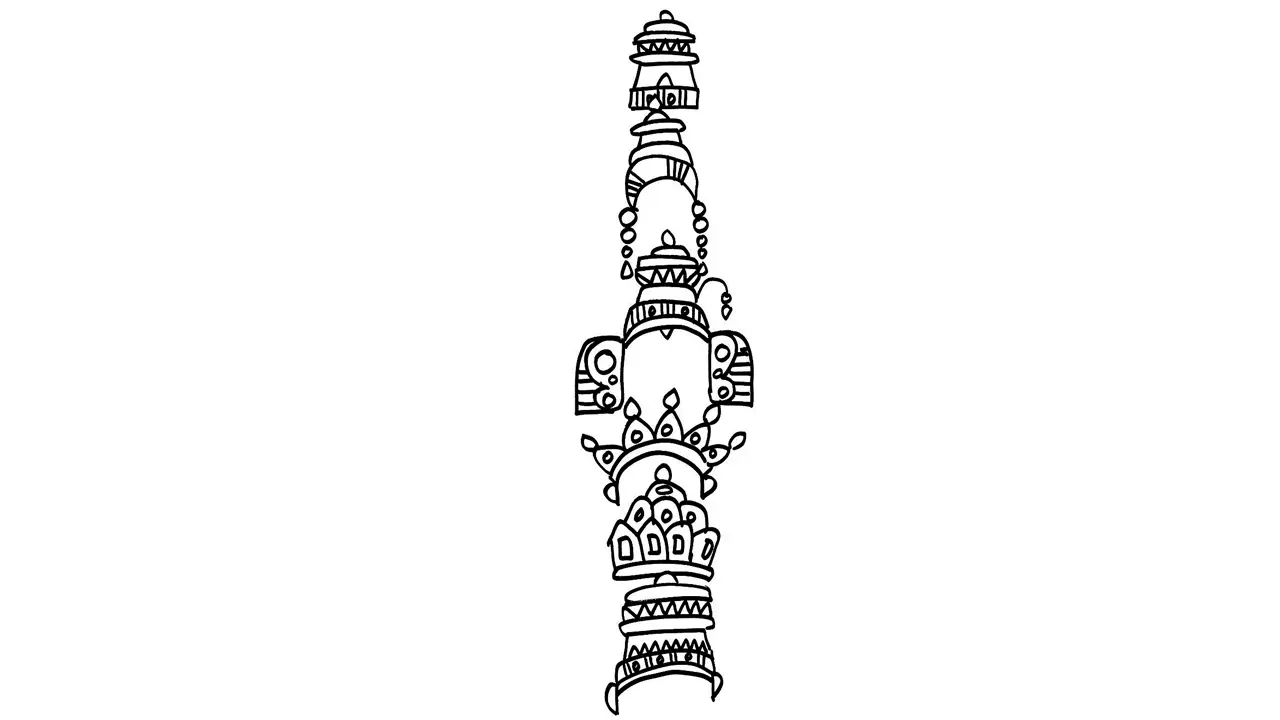Tamil merchants even built a Shiva temple in Quanzhou, China, around 700 years ago.

Illustration/Devdutt Pattanaik
 If you travel to Vietnam, you can go to MySon and see Hindu temples there which are over 1000 years old. Images of Shiva, Vishnu, Lakshmi— there are Hindu images, but the gods do not wear the sacred thread associated with Brahmins. Similar images of Hindu gods are found in Cambodia’s Angkor Vat and in Java island’s Prambanan temple. There are images of war: Ram fighting Ravana, Krishna fighting Bana, Indra fighting Asuras. Yama sits on a buffalo. Shiva sits atop a mountain. There are also Buddha’s images, especially of Avalokiteshwara, popular with sailors. Tamil merchants even built a Shiva temple in Quanzhou, China, around 700 years ago.
If you travel to Vietnam, you can go to MySon and see Hindu temples there which are over 1000 years old. Images of Shiva, Vishnu, Lakshmi— there are Hindu images, but the gods do not wear the sacred thread associated with Brahmins. Similar images of Hindu gods are found in Cambodia’s Angkor Vat and in Java island’s Prambanan temple. There are images of war: Ram fighting Ravana, Krishna fighting Bana, Indra fighting Asuras. Yama sits on a buffalo. Shiva sits atop a mountain. There are also Buddha’s images, especially of Avalokiteshwara, popular with sailors. Tamil merchants even built a Shiva temple in Quanzhou, China, around 700 years ago.
But then, the sea-merchants of India outsourced all travel to Arab merchants. And a new form of Buddhism spread after the 10th century, not from India, but from Sri Lanka. The Theravada school, with its Pali canon, had images of Buddha sitting, standing and lying down. These images of the Buddha and his stupa (now called pagoda as they reached to the sky) became popular in Myanmar and Thailand. Both these states resisted Islamisation and later, Christian missionaries.
We remember this connection of Hinduism with Southeast Asia only when we realise that the airport in Bangkok is called Suvarnabhumi Airport and it is adorned with images of the churning of the ocean. But the gods and demons look so different — the serpent looks like a Chinese dragon. It has its own character. The Hindu influence exists, but is distant. Though it allows Sanatanis to bloom with pride — as if they civilised this part of the world.
South India merchant guilds were the dominant force: not the north. We know this because the earliest inscriptions in South-East Asia have the cursive script of Southern Brahmi. Even as these inscriptions, like the ones found in Western Java, were written in Sanskrit, the script was a cursive Southern Brahmi, and the rounded Dravidian scripts. The palm leaf writing technique using iron stylus was popular. From 300 AD to 1300 AD, for a thousand years, Sanskrit was a court language, the language of kings and merchants.
This trade presence brought in both Brahmins and Buddhists, many of whom became counsellors to local kings, and some, like the ash-smearing Pashupata Shaivas captured the imagination of the Khmer kings in Cambodia. Kings were performing tirthas or pilgrimages to local mountains, and lingas were mushrooming across Cambodia on riverbeds.
In the earlier period, the Brahmins were like sorcerers — they invoked the spirit of the divine (Shiva, Avalokiteshwara) within the body of the king. This made him attractive to fortune. He attracted soldiers, merchants, treasures and brought property around him. His capital was the centre of the world, like the lotus flower emerging from the navel of Vishnu, around which the kingdom flourished. As long as he performed the rituals and got people to perform the rituals, the prosperity remained. The fields got irritated, new fields were created, harvest came, bounty came, and with it festivals where Ramayana could be performed, and dancing girls could captivate the imagination of people, show them what Indra’s paradise is like after death.
These Mandala kingdoms rose typically in river valleys lined with mountains: the Irrawaddy river basin of Burma, the Chao Phraya river basin of Thailand, the Mekong river basin of Cambodia and Vietnam. They may also have been the secret of the success of the Chola empire too in Kaveri river basin.
The author writes and lectures on the relevance of mythology in modern times. Reach him at devdutt.pattanaik@mid-day.com
 Subscribe today by clicking the link and stay updated with the latest news!" Click here!
Subscribe today by clicking the link and stay updated with the latest news!" Click here!










